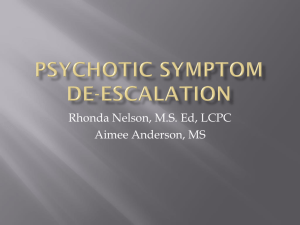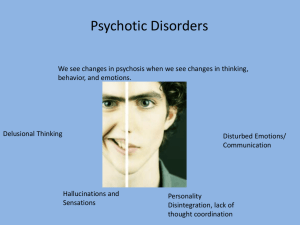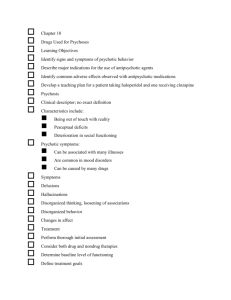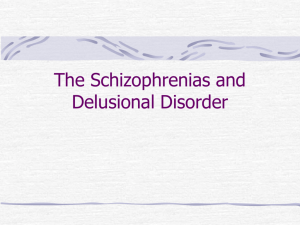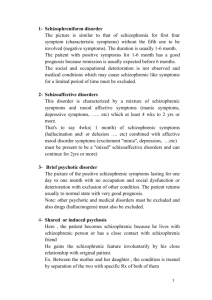DSM-IV
advertisement
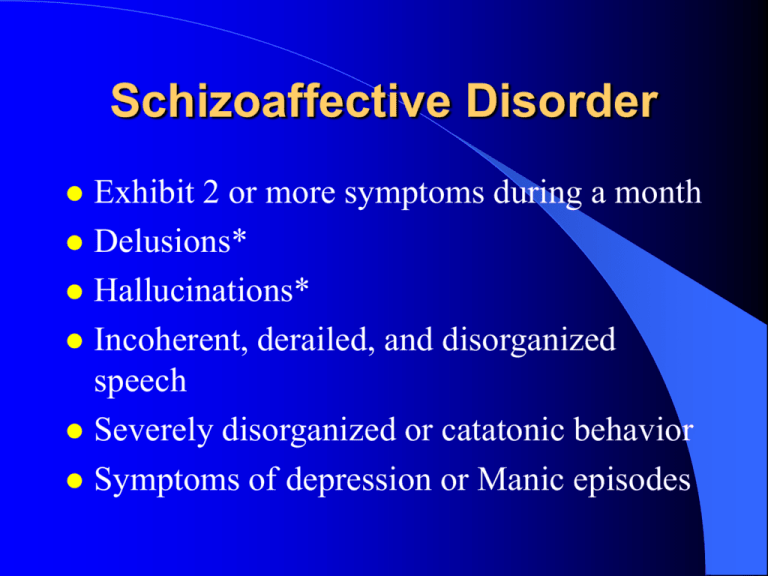
Schizoaffective Disorder Exhibit 2 or more symptoms during a month Delusions* Hallucinations* Incoherent, derailed, and disorganized speech Severely disorganized or catatonic behavior Symptoms of depression or Manic episodes Delusional Disorder Criterion A for Schizophrenia never met Nonbizarre delusions for at least 1 month Functioning not obviously impaired If mood disturbances occur, their total duration is brief relative to the duration of the delusional symptoms Not due to substance or GMC Delusional D/O vs. Schizophrenia Later age of onset Associated with family traits (including suspiciousness, jealousy, and secretiveness) as opposed to history of psychotic sxs. Frequently re-diagnosed as Schizophrenia Hallucinations are present, but rare Brief Psychotic Disorder Psychotic for at least a day and then return to baseline At least one symptom (delusions, hallucinations, disorganized speech Not due to mood disorder, Schizophrenia or Schizoaffective Disorder Shared Psychotic Disorder Someone closely associated with a delusional person also develops a delusion Content of delusion similar to that of the 1st person’s delusion Not explained by other Psychotic disorders or GMC Psychotic Disorder NOS Charles Bonnet syndrome Postpartum psychosis Auditory hallucinations Dissociative Amnesia • One or more episodes of an inability to recall important personal information that cannot be attributed to ordinary forgetfulness. • Usually related to gaps in memories related to traumatic events • A chronic, yet reversible amnesia Dissociative Fugue • Abrupt, unexpected travel away from home or work with an inability to recall some or all of one’s past. • Individuals exhibit confusion about his/her personal identity or a partial or total assumption of new identity. • May seem “normal” during the fugue, but following recovery, the person may not recall events that took place during the fugue • Very rare and occurs most during wartime or following a natural disaster Dissociative Identity Disorder* • Existence in one individual of two or more distinct identities or personality states that each has its own pattern of perceiving, relating to, and thinking about the environment and self. • At least 2 of the personalities take control of the person’s behavior in sequence, with gaps in recent & past memories for personal information. • Personalities are typically unique and change abruptly occasionally triggered by stress or external cues. Depersonalization Disorder • One or more episodes of depersonalization, which involves a feeling of detachment or estrangement from oneself. • Reality testing is intact • Symptoms are severe enough to cause significant distress or functional impairment Dissociative Disorders NOS • Derealization without depersonalization • Brainwashing • Coma/Loss of consciousness • Ganser’s Syndrome • Dissociative Trance Disorder Impulse Disorders Intermittent Explosive Disorder • Several occasions of losing control of aggressive impulses, leading to serious assault or property destruction • Aggression is markedly out of proportion to the seriousness of any social or psychological stressors • Not due to PDO or GMC Kleptomania • A repeated pattern of an irresistible impulse to steal unneeded objects. • Produces a buildup of tension and “release” once action is performed • Thefts are not committed out of anger, revenge, or in response to hallucination or delusions • Not better explained by APDO, Conduct DO or Manic Episode Pyromania • A repeated and irresistible urge to set or be attracted to fires • Produces a buildup of tension and “release” once action is performed • Not better explained by APDO, Conduct D/O, or Manic Episode Trichotillomania • Recurrent failure to resist pulling out one’s own hair. • Produces a buildup of tension and “release” once action is performed Pathological Gambling • Repeated gambling (and associated activities) usually to the point of losing money, job, and friends. • Produces buildup of tension and “release” once action is performed
